Not sure which camera is right for your project? This guide will walk you through the key features and ideal uses for each of the cameras in the Film/Media Studies collection.
Sony RX10 II
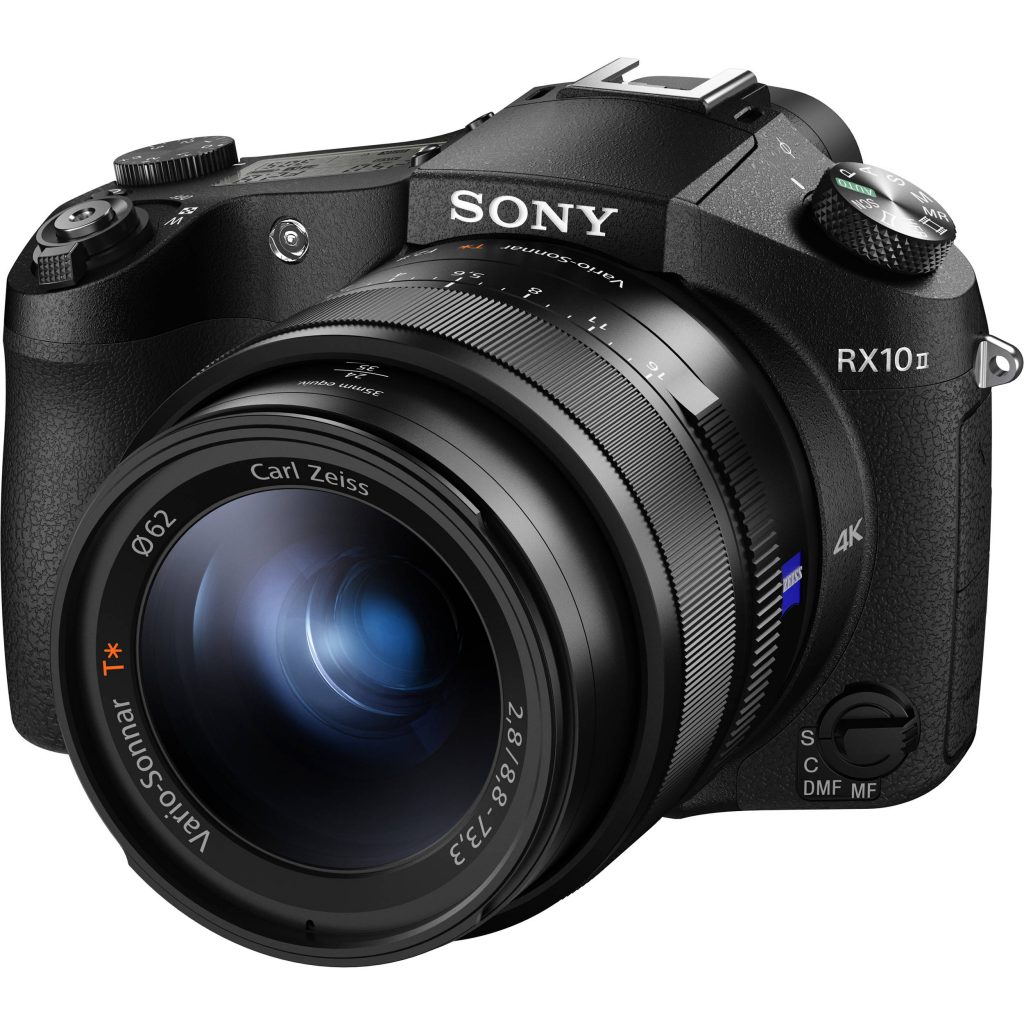
Key Features
- 4K recording
- Slow motion recording
- Built-in lens with 24-200mm (equivalent) zoom, f/2.8
- Built-in ND filters
- Compatible with Sony K2M XLR adapter
- Small size, lightweight
Ideal Uses
Documentary, run-and-gun, slow motion
Pros and Cons
+ Compact, versatile lens, great recording options
– Weak battery life, fixed lens, small sensor
Overview
The RX10 II is a compact fixed-lens camera with advanced video features you might not expect on a camera of this size. The built-in lens has a long zoom range, equivalent to 24mm to 200mm, with a constant f/2.8 aperture. This camera can capture 4K footage at 24 frames per second or full HD (1080p) footage at up to 120 frames per second. There is also an extreme slow motion mode, which will capture a short burst of footage at 240, 480, or 960 frames per second, although the video quality decreases as the frame rate goes up. Other video-centric features include built-in ND filters, image stabilization, and a headphone jack for monitoring audio. An external microphone can be attached using either a 3.5mm port or by using the Sony K2M XLR adapter, which mounts to the top of the camera. Overall, the RX10 II is a very well-rounded camera, especially when size and weight are a major concern.
Suggested Accessories
Sony K2M XLR adapter, mid-size tripod
Additional Information
Panasonic GH4
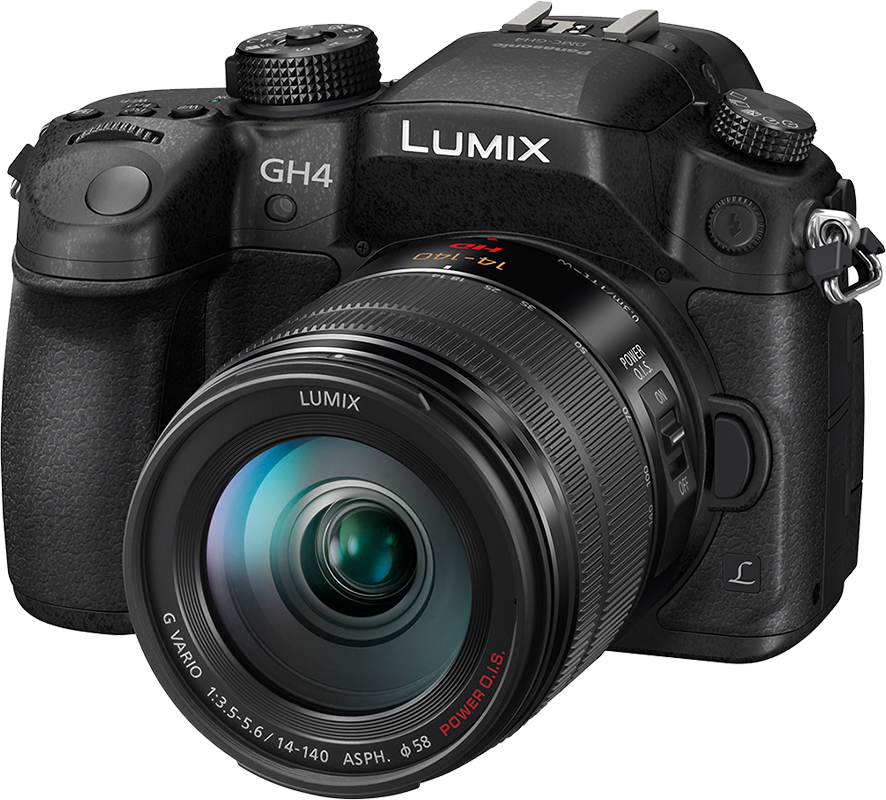
Key Features
- 4K video recording at 24 or 30 frames per second
- Full HD video recording at up to 96 frames per second for slow motion shots
- Micro 4/3 lens mount can be used with native or adapted lenses
- Articulating rear screen
- Small size, lightweight
Ideal Uses
Documentary, short film, music video
Pros and Cons
+ Great handling and controls, good battery life, good image quality, 4K recording, slow motion
– Limited audio options
Overview
The GH4 is the successor to the GH3 and adds several new features while retaining the GH3’s core functionality. The most significant additions are 4K recording and full HD slow motion. Like the GH3, it offers intuitive handling, long battery life, and excellent video quality.
Suggested Accessories
RODE VideoMicro, mid-size tripod, Panasonic 12-35mm zoom lens
Additional Information
Camera guide, Camera manual part 1, Camera manual part 2
Panasonic GH5

Key Features
- 4K video recording at up to 60 frames per second
- Full HD video recording at up to 180 frames per second for slow motion shots
- Micro 4/3 lens mount can be used with native or adapted lenses
- Built-in image stabilization for smooth handheld footage
- Twin SD card slots for extended recording time
- Articulating rear screen
- Small size
Ideal Uses
Documentary, short film, music video
Pros and Cons
+ Great handling and controls, good battery life, good image quality, 4K recording, slow motion, image stabilization
– Limited audio options, heavier than other GH cameras
Overview
The Panasonic GH5 builds on the strengths of the GH3 and GH4, adding a number of high-end video features. These include additional 4K recording modes, improved slow motion capabilities, two SD card slots for extended recording or backups, and advanced in-body image stabilization. The image stabilization is a standout feature, allowing smooth footage to be captured even when filming handheld or with an adapted lens. The GH5 is an incredibly versatile camera and is appropriate for a variety of situations.
Suggested Accessories
GH5 battery grip, RODE VideoMicro, mid-size tripod, Panasonic Leica 12-60mm zoom lens
Additional Information
Sony FS5
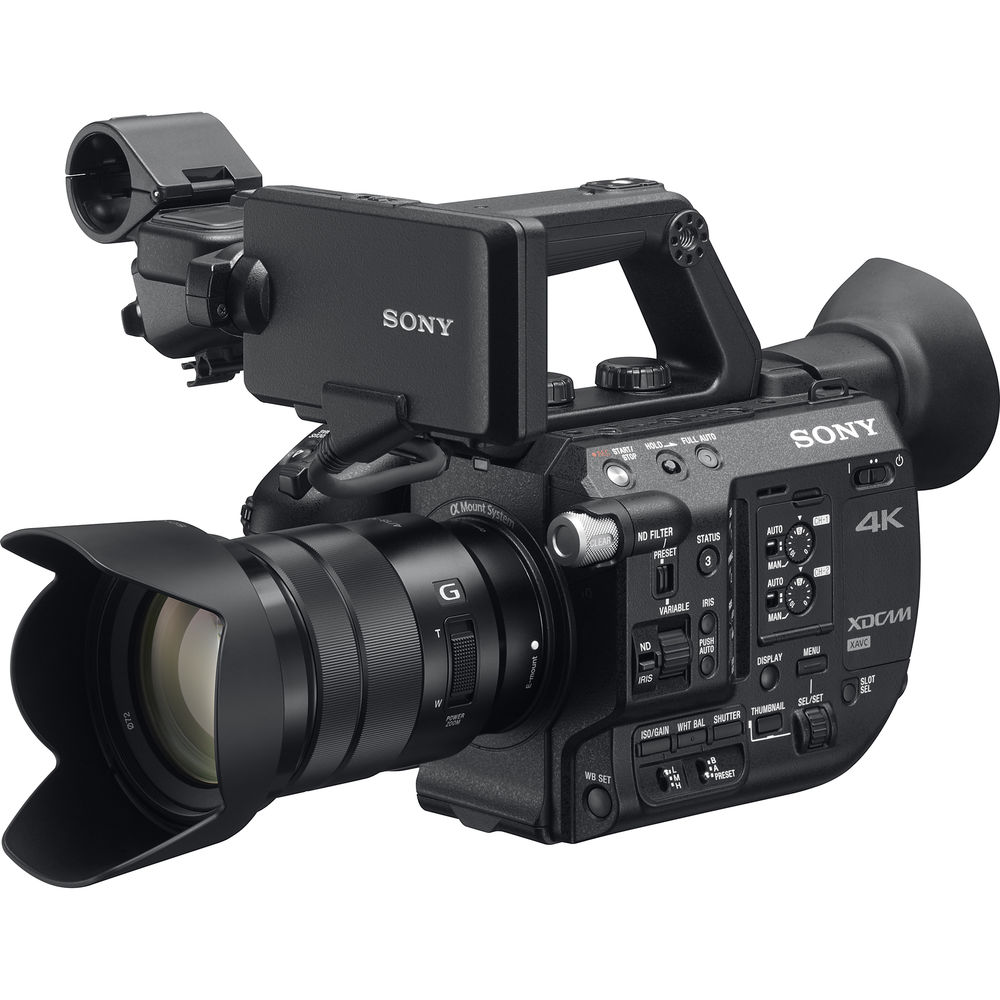
Key Features
- 4K recording
- Slow motion recording
- Built-in ND filters
- Two XLR inputs with phantom power
- Long battery life
Ideal Uses
Documentary, sit-down interviews, short film, event video
Pros and Cons
+ Excellent image quality, lots of recording options, XLR audio inputs, advanced video features
– Steep learning curve
Overview
The Sony FS5 has all of the features you would want in a professional camcorder-style camera – XLR inputs, built-in ND filters, scopes, focus peaking, long battery life, and dual SD card slots. However, the FS5 also has newer features such as 4K recording and slow motion options, creating a very complete package. While it isn’t a small camera, the FS5 is still comfortable to shoot with handheld, making it well suited for a variety of situations. The camera can be paired with a versatile 18-105mm Sony zoom lens, or a Nikon mount prime lens using an adapter. The long list of features and options on the FS5 mean that it takes longer to learn how to use than some other cameras, but it’s a powerful cinematic tool.
Suggested Accessories
Shotgun microphone, large tripod, Sony 18-105mm zoom lens
Additional Information
Sony FX3
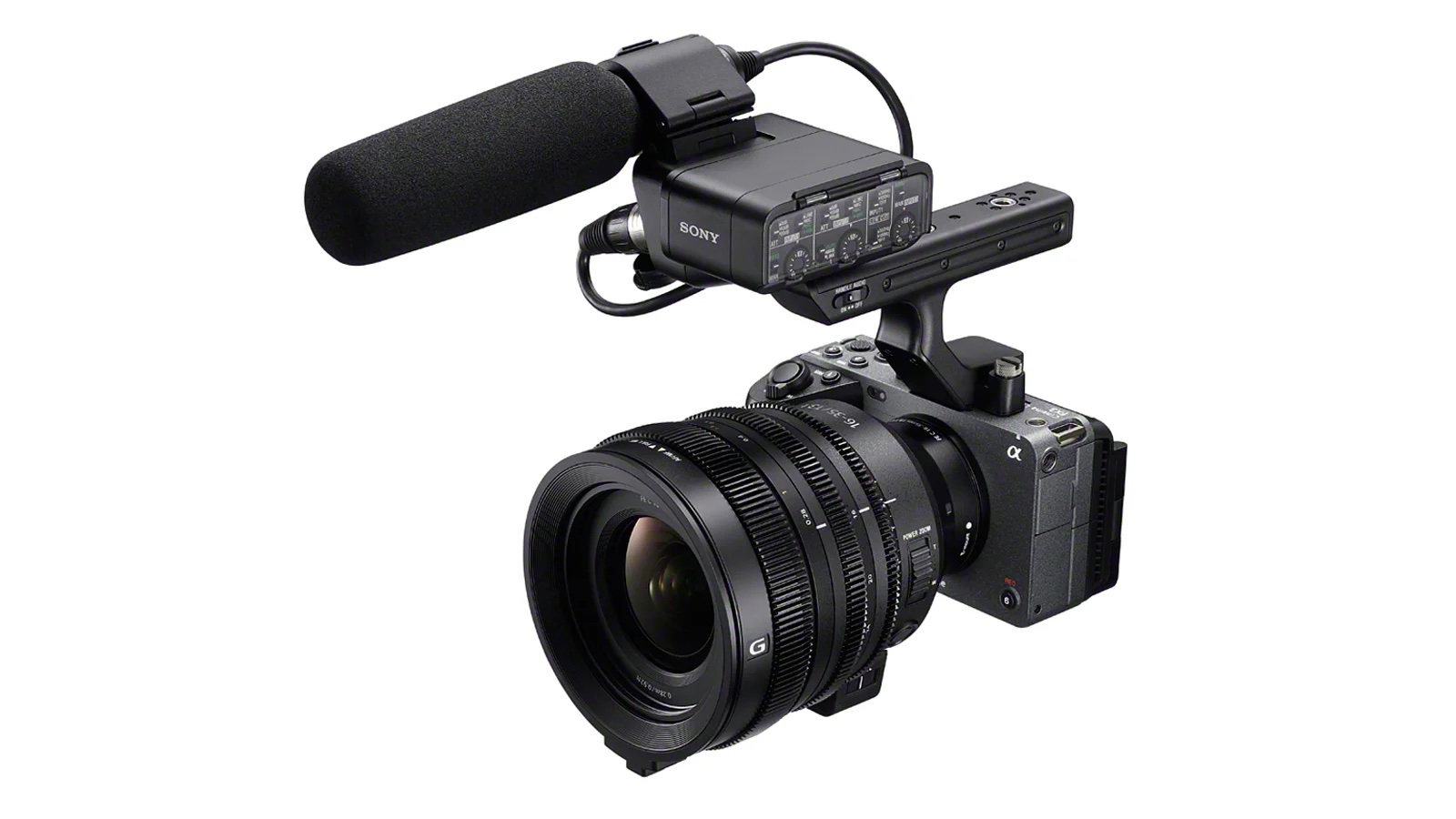 Key Features
Key Features
- 4K recording
- Slow motion recording
- Top handle with XLR inputs
- Large Full Frame sensor
- Advanced autofocus capabilities
Ideal Uses
Short film, music video
Pros and Cons
+ Large sensor, XLR top handle, autofocus
– Some formats require special media, complicated menu system, no viewfinder
Overview
The FX3 is a compact professional camera with a full frame sensor, allowing good performance in low light conditions. The kit includes a removable top handle attachment with two powered XLR inputs. The camera can record 4K footage at high frame rates, although some recording options are limited when using standard SD cards. The camera’s standout feature – besides its large sensor – is its autofocus capability. This makes it a good option for situations when focusing manually is impractical, such as when the camera is mounted on a crane or gimbal.
Suggested Accessories
Small shotgun microphone, gimbal
Additional Information
Blackmagic Pocket Cinema Camera 6K Pro
Key Features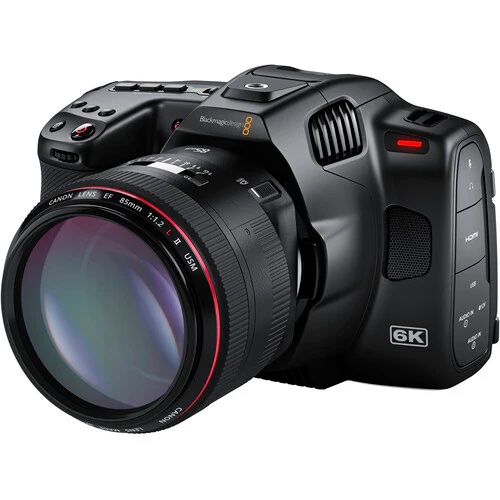
- 6K Raw video recording
- Built-in ND filters
- Built-in Micro-XLR ports
- APS-C sensor with Canon EF lens mount
- External SSD recording
Ideal Uses
Short film, studio-based work
Pros and Cons
+ Built-in ND filters, raw video recording, SSD recording, XLR inputs using adapter, large rear screen
– Bad battery life, large size, heavy, requires rigging and accessories
Overview
Despite the “pocket” moniker, this camera is quite large and fairly heavy. The 6K Pro has some very unique capabilities, including the option to record ProRes and Blackmagic Raw video directly to an external SSD. This makes it possible to record for much longer than you can on an SD card. The camera also has three levels of built-in ND filters and two micro-XLR inputs. The sensor is APS-C with a Canon EF lens mount and can record up to 6K resolution, when using the BRAW format on an external SSD. However, the camera’s unusual body style and extremely poor battery life make it poorly-suited for extended handheld use – it is ideal for tripod-based shooting with either an external power supply (a D-tap adapter is available for use with large gold-mount batteries) or plugged into a wall outlet using the included AC adapter. Despite its many advanced features, the camera’s menu system is straightforward and easy to navigate, making it a relatively simple camera to use.
Suggested Accessories
Micro XLR cable adapter and shotgun microphone, large tripod, Nikon to Canon lens adapter, follow focus, D-tap power adapter and gold mount battery
Additional Information
DJI Osmo
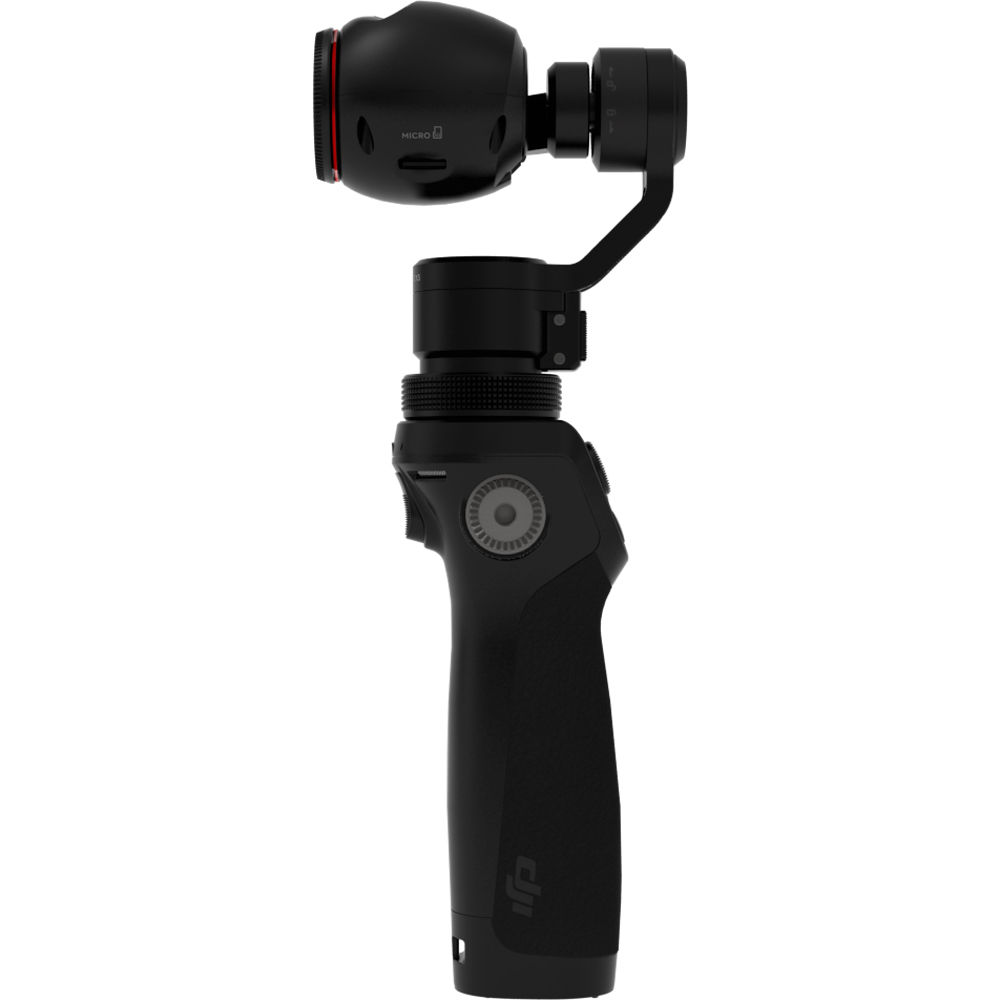
Key Features
- 3-axis gimbal stabilization
- 4K recording
- Slow motion recording
- Built-in wide angle 20mm (equivalent) lens
Ideal Uses
Steadicam-style shots, music videos
Pros and Cons
+ Advanced stabilization modes, small form factor, lots of recording options
– Fixed lens, small sensor, no good on-camera audio options
Overview
The DJI Osmo is a small camera with a wide-angle lens that is permanently attached to a 3-axis gimbal electronic stabilizer. (Gimbal stabilizers use small motors to keep cameras steady and remove unwanted movement and shake – they are, essentially, electronic Steadicam rigs.) It has limited audio capabilities and a fixed lens, so it is not a good “general use” camera; the Osmo is a specialty tool used to capture smooth moving shots. Since there is no screen on the camera itself, it must be paired with a cell phone. The Osmo can film at 4K resolution or at full HD (1080p) in a variety of frame rates for slow motion footage.
Suggested Accessories
RODE VideoMicro
Additional Information
Krasnogorsk-3

Key Features
- 16mm film recording
- All mechanical operation
- Animation and time-lapse capabilities
- 17-69mm f/1.9 lens
Ideal Uses
Short film, introduction to 16mm production
Pros and Cons
+ Simple operation, all mechanical, versatile lens
– Limited recording options, heavy
Overview
For students interested in learning to shoot on 16mm film, the Krasnogorsk-3 is a great option. The camera is relatively simple and straightforward and the included lens is versatile. This camera does not record audio, so a separate recorder will need to be used for sound capture.
Suggested Accessories
Large tripod, Tascam DR-40 audio recorder
Additional Information
Bolex H16 Reflex
Key Features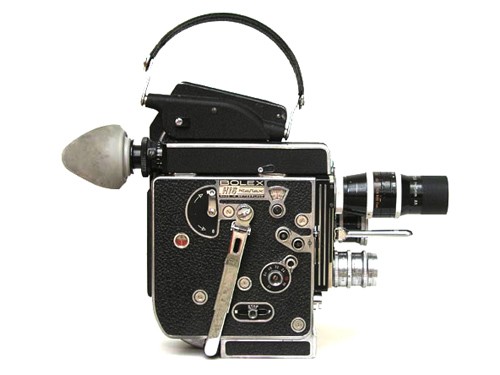
- 16mm film recording
- All mechanical operation
- Animation and time-lapse capabilities
- Fade, cross dissolve, and multiple exposure capabilities
- Triple lens bayonet mount
Ideal Uses
Short film, advanced 16mm production
Pros and Cons
+ Advanced recording features, triple lens mount
– Complex operation, fragile
Overview
The Bolex H16 is the more advanced of our two 16mm film cameras. It has the ability to do sophisticated in-camera effects such as double exposures, fades, and cross dissolves. The rotating front bayonet mount allows three lenses to be mounted to the camera for fast switching between different focal lengths. Our kit includes a 10mm f/1.6, a 25mm f/1.5, and a 75mm f/1.9 lens.
Suggested Accessories
Large tripod, Tascam DR-40 audio recorder
Additional Information
Camera manual, hand grip accessory manual, shutter release accessory manual